1222 Read online
1222 metres above sea level, train 601 from Oslo to Bergen careens off iced rails as the worst snowstorm in Norwegian history gathers force around it. Marooned in the high mountains with night falling and the temperature plummeting, its 269 passengers are forced to abandon their snowbound train and decamp to a centuries-old mountain hotel. They ought to be safe from the storm here, but as dawn breaks one of them will be found dead, murdered.
With the storm showing no sign of abating, retired police inspector Hanne Wilhelmsen is asked to investigate. But Hanne has no wish to get involved. She has learned the hard way that truth comes at a price and sometimes that price just isn't worth paying. Her pursuit of truth and justice has cost her the love of her life, her career in the Oslo Police Department and her mobility: she is paralysed from the waist down by a bullet lodged in her spine.
Trapped in a wheelchair, trapped by the killer within, trapped by the deadly storm outside, Hanne's growing unease is shared by everyone in the hotel. Should she investigate, or should she just wait for help to arrive? And all the time rumours swirl about a secret cargo carried by train 601. Why was the last carriage sealed? Why is the top floor of the hotel locked down? Who or what is being concealed?
And, of course, what if the killer strikes again?
Anne Holt is Norway's bestselling female crime writer. She spent two years working for the Oslo Police Department before founding her own law firm and serving as Norway's Minister for Justice between 1996 and 1997. She is published in 25 languages with over 5 million copies of her books sold in Europe.
1222
1222
ANNE HOLT
Translated by Marlaine Delargy
First published in the English language in Great Britain in 2010 by Corvus, an imprint of Atlantic Books Ltd.
Originally published in Norwegian in 2007 by Piratforlaget AS, Postbooks 2318 Solli, 0201 Oslo.
Published by agreement with Salomonsson Agency.
Copyright © 2007 by Anne Holt.
Translation copyright © 2010 by Marlaine Delargy.
The moral right of Anne Holt to be identified as the author of this work has been asserted in accordance with the Copyright, Designs and Patents act of 1988.
All rights reserved. No part of this publication may be reproduced, stored in a retrieval system, or transmitted in any form or by any means, electronic, mechanical, photocopying, recording, or otherwise, without the prior permission of both the copyright owners and the above publisher of this book.
This is a work of fiction. All characters, organizations, and events portrayed in this novel are either products of the author’s imagination or are used fictitiously.
9 8 7 6 5 4 3 2 1
A CIP catalogue record for this book is available from the British Library.
ISBN: 978-1-84887-607-1 (hardback)
ISBN: 978-1-84887-608-8 (trade paperback)
eBook ISBN: 978-0-85789-251-5
Printed in Great Britain.
Corvus
An imprint of Atlantic Books Ltd
Ormond House
26-27 Boswell Street
London WC1N 3JZ
www.corvus-books.co.uk
This book is a little bit serious and a lot of fun, Iohanne.
That’s why it’s my first little book for you.
CONTENTS
Chapter 1
Chapter 2
Chapter 3
Chapter 4
Chapter 5
Chapter 6
Chapter 7
Chapter 8
Chapter 9
Chapter 10
Chapter 11
Chapter 12
Chapter 13
i
As it was only the train driver who died, you couldn’t call it a disaster. There were 269 people on board when the train, due to a meteorological phenomenon that I have not yet understood completely, came off the rails and missed the tunnel through Finsenut. A dead train driver comprises only 0.37 per cent of this number of people. Given the circumstances, in other words, we were incredibly lucky. Although many individuals were injured in the collision, these injuries were mostly minor in nature. Broken arms and legs. Concussion. Superficial cuts and grazes, of course; there was hardly one person on board who wasn’t physically marked in some way after the crash. But only one fatality. Judging by the screams that ripped through the train minutes after the accident, one could have gained the impression that a total disaster had taken place.
I didn’t say anything for quite some time. I was convinced that I was one of only a few survivors, and besides I had a tiny baby I had never seen before in my arms. It came flying from behind when the impact occurred, brushed against my shoulder and hit the wall right in front of my wheelchair before landing on my lap with a soft thud. In a pure reflex action I put my arms around the bundle, which was yelling. I started to get my breath back, and became aware of the dry smell of snow.
The temperature dropped from unpleasant static heat to the level of cold that threatens frostbite within a remarkably short time. The train listed to one side. Not very much, but enough to cause pain in one of my shoulders. I was sitting on the left in the carriage, and was the only person in a wheelchair on the entire train. A wall of dirty white was pressing against the window on my side. It struck me that the enormous quantities of snow had saved us; without them the train would have jack-knifed.
The cold was debilitating. I had taken off my sweater back in Hønefoss. Now I was sitting here in a thin T-shirt, clutching a baby to my chest as I realized it was snowing into the carriage. The bare skin on my arms was already so cold that the whirling, blue-white flakes lay there for a chilly second before melting. The windows had caved in all along the right-hand side of the carriage.
The wind must have increased in strength during the few minutes that had passed since we stopped to allow people to get on and off the train at Finse station. Only two passengers had disembarked. I had noticed how they leaned forward against the wind as they struggled across the platform towards the entrance to the hotel, but it didn’t seem any worse than normal bad weather up in the high mountains. Sitting here now, with my sweater tightly wrapped around the baby and with no chance of being able to reach for my jacket, I was afraid that the wind was so strong and the snow so cold that we would freeze to death within a very short time. I curled my body over the tiny baby as best I could. With hindsight I can’t actually say how long I sat like that, without any contact with anyone, without saying anything, with the shouts of the other passengers like disconnected fragments in the dense howling of the storm. Perhaps it was ten minutes. It might have been only a few seconds.
‘Sara!’
A woman was glaring furiously at me and the child, which was entirely pink, from its cardigan to its tiny little socks. The small, clenched fists that I was trying to cover with my own hands, along with the furious, yelling face, had a pale pink tinge.
The mother’s face, on the other hand, was blood-red. A deep cut in her forehead was bleeding freely. That didn’t stop her from grabbing the baby. My sweater fell to the floor. The woman wound a blanket around her daughter with such speed and skill that this couldn’t possibly be her first-born child. She tucked the little head inside the folds, pressed the bundle to her breast and yelled accusingly at me:
‘I fell! I was moving along the carriage and I fell!’
‘It’s OK,’ I said slowly; my lips were so stiff that I had difficulty speaking. ‘Your daughter isn’t hurt, as far as I can tell.’
‘I fell,’ sobbed the mother, kicking out at me without making contact. ‘I dropped Sara. I dropped her!’
Freed from the troublesome child, I picked up my sweater and put it on. Despite the fact that I was on the way to Bergen, where I was expecting pouring rain and a temperature of plus two,
I had brought my padded jacket. Eventually I managed to get it down off the hook on which it was still hanging, miraculously. In the absence of a hat, I knotted my scarf around my head. I didn’t have any gloves.
‘Calm down,’ I said, tucking my hands into the sleeves of my jacket. ‘Sara’s crying. That’s a good sign, I think. But I’m more concerned about ...’
I nodded in the direction of her forehead. She paid no attention. The child was still crying and was determined not to be consoled by her mother, who was trying to tuck her inside her own fur coat, which was far too tight. Blood was pouring from her forehead, and I could swear it was freezing before it reached the sloping floor, which was now covered in snow and blood and ice. Somebody had trodden on a carton of orange juice. The yellow lump of ice lay in the middle of all the whiteness like a great big egg yolk.
The warmth refused to come back into my body. On the contrary, it was as if my thicker clothing was making the situation worse. True, the numbness was slowly receding, but it was being replaced by piercing, stabbing pains in my skin. I was shaking so hard I had to clench my teeth to avoid biting my tongue. Most of all I wanted to try to turn my wheelchair around so that I was facing all the cries, facing the weeping of a woman who must be right behind me, and the torrent of swear words and curses coming from someone who sounded like a teenage boy whose voice was just breaking. I wanted to find out how many people were dead, how badly injured the survivors were, and if there was any way of securing the windows against which the wind was pressing as it increased in strength with every passing second.
I wanted to turn around, but I couldn’t bring myself to take my hands out of the sleeves of my jacket.
I wanted to look at my watch, but couldn’t bear the thought of the cold against my skin. Time was as blurred to me as the whirling snow outside the carriage, a chaos in grey with strips of blue-lilac glimmers from the lights that had started to flicker. I couldn’t grasp the idea that it was possible to be so cold. More time must have passed since the crash than I thought. It must be colder than the train driver had said over the loudspeaker on our way into Finse. He had warned the smokers: it was minus twenty, and not a particularly clever idea to try to grab a couple of minutes’ pleasure. He must have been wrong. I have experienced temperatures of minus twenty many times. It has never felt like this. This was a deadly cold, and my arms refused to obey me when I decided to check the time in spite of everything.
‘Hello there!’
A man had forced open the automatic glass doors leading to the luggage racks. He stood on the sloping floor with his legs wide apart, wearing a snowmobile suit, a thick leather hat with earflaps and a pair of bright yellow ski goggles.
‘I’ve come to rescue you!’ he bellowed, pulling his goggles down around his neck. ‘Just take it easy. It’s not far to the hotel.’
His accent indicated that he was local.
I couldn’t quite work out what one man was going to be able to do in this carriage full of wailing people. And yet it was as if his very presence had a calming effect on us all. Even the pink baby stopped crying. The boy who had been swearing non-stop since the crash yelled out one last salvo:
‘It’s about fucking time somebody turned up! Fucking hell!’
Then he shut up.
I might have fallen asleep. Perhaps I was in fact on the point of freezing to death. At any rate, the cold was no longer so troublesome. I’ve read about that sort of thing. Even if I can’t claim that I felt the pleasant drowsiness that is said to precede death from the cold, my teeth had at least stopped chattering. It was as if my body had decided on a change of strategy. It no longer wanted to fight and shake. Instead I could feel muscle after muscle giving in and relaxing. At least in that part of my body where I still have feeling.
I’m not sure if I fell asleep.
But something has disappeared from my memory. The rescuer must have helped quite a lot of people before I gave a sudden start.
‘What the hell ...’
He was bending over me. His breath was burning against my cheek, and I think I smiled. Immediately after that he squatted down and examined my knees. Or rather my thigh, as I would soon learn.
‘Are you disabled? Are your legs crippled? From before, I mean?’
I didn’t have the strength to answer.
‘Johan,’ he shouted suddenly, without getting up. ‘Johan, over here!’
He was no longer alone, then. I could hear the sound of an engine through the storm, and the gusts of wind from outside carried with them the faint smell of exhaust fumes. The roaring noise came and went, grew louder and then faded away, and I came to the conclusion that there must be several snowmobiles at work. The man called Johan knelt down and scratched his beard when he saw what his friend was pointing at.
‘You’ve got a ski pole through your thigh,’ he said eventually.
‘What?’
‘You’ve got a ski pole right through your thigh.’
He shook his head in fascination.
‘The loop snapped off when it hit you and caught on your trousers, but the pole itself ...’
His head vanished from my field of vision.
‘It’s sticking out about twenty centimetres on the other side,’ he called out. ‘You’ve bled a bit. Well, quite a lot, actually. Are you cold? I mean, are you colder than ... It looks as if the pole is slightly bent, so ...’
‘We can’t pull it out,’ said the man with the yellow goggles around his neck, so quietly that I only just heard him. ‘She’d bleed to death. Who’s been stupid enough to put a pair of poles in here?’
He looked around accusingly.
‘We need to get her out of here right now, Johan. But what the hell are we going to do with the pole?’
I don’t really remember anything else.
And so of the 269 people on board train number 601 from Oslo to Bergen on Wednesday 14 February 2007, only one person lost his life in the crash. He was driving the train, and can hardly have grasped what was happening before he died. Incidentally, we didn’t crash into the mountain itself. At the foot of Finsenut, a concrete pipe has been sunk into the rock, as if someone thought that the ten-kilometre tunnel wasn’t long enough as it was, and therefore needed to be supplemented with several metres of ugly concrete in the otherwise beautiful landscape around the lake known as Finsevann. Subsequent investigations would show that the actual derailment occurred exactly ten metres from the opening. The cause was the fact that the rails had acquired a comprehensive covering of ice. Many people have tried to explain to me how such a thing could happen. Two goods trains had passed in the opposite direction during the course of an hour before the accident happened. As I understand it, they had pushed the warmer air in the tunnel out into the increasingly colder air outside. Just like in a bicycle pump, somebody told me. Since it is more difficult for cold air to retain moisture than it is for warm air, the condensation from inside turns to droplets, which fall to the ground and turn into ice. And more ice. So much ice that not even the weight of a train can crush it in time. Since then I have thought that although I couldn’t see the point of the concrete pipe at the time, it was probably put there to create a gradual cooling of the air inside the tunnel. So far, nobody has been able to tell me if I am right.
It lies far beyond my comprehension that a weather phenomenon that must have been known since time immemorial can derail a train on a railway that has been in use since 1909. I live in a country with countless tunnels. We Norwegians should have a good knowledge of snow and ice and storms in the mountains. But in this hi-tech century with planes and nuclear submarines and the ability to place a vehicle on Mars, with the ability to clone animals and to carry out laser surgery that is accurate to the nearest nanometre, something as simple and natural as the air from a tunnel coming into contact with a snowstorm can derail a train and smash it against a huge concrete pipe.
I don’t understand it.
Afterwards, the accident was referred to as the Finse disaster
. Since it wasn’t in fact a disaster but rather a major accident, I have come to the conclusion that the designation has been coloured by everything else that happened in and around the railway station 1222 metres above sea level in the hours and days following the collision, as the storm increased to the worst in over one hundred years.
ii
I was lying on the floor in a shabby hotel reception area when I came round. An all-pervasive smell of wet wool and stew assailed my nostrils. Just above my head a stuffed reindeer was staring glassily into the distance. Without looking I was aware that the room was full of people, weeping, sitting in silence or babbling agitatedly.
Slowly I tried to sit up.
‘Don’t do that,’ said a voice I recognized from the train.
‘I have to get going,’ I said blearily to the reindeer.
The man in the blue snowmobile suit suddenly appeared in my field of vision. Bending down with his head between the animal and me, he looked as if he had antlers.
‘You’re going to have to stay here for a while,’ he said with a grin. ‘Like the rest of us. My name is Geir Rugholmen, by the way. What’s yours?’
I didn’t reply.
I wasn’t planning on making acquaintances during this trip. True, Finse has no road links with the outside world. Even during the summer the historic Rallarvegen is closed to general traffic. In the winter it is, at best, a snowmobile track. With a wrecked train across the railway track on the Bergen line and a snowstorm that to all intents and purposes appeared to be gaining in strength, I still thought it was only a question of time before Norwegian State Railways’ enormous snow ploughs would be able to battle their way up from Haugastøl or Ustaoset in the east, and would move us all safely. I wasn’t going to get to Bergen this time, but none of us would be staying in Finse for very long.
iii
It turned out there were eight doctors among the passengers from the train that had crashed. A fortunate over-representation that could be explained by the fact that seven of them were due to take part in a conference at Haukeland University Hospital on the treatment of burns. I was also on my way there when the train was derailed. Not to the conference on burns, of course, but to see an American specialist on the complications following a broken spine. Since I was shot in the back and paralysed from the waist down one night between Christmas and New Year in 2002, the rest of my body has begun to suffer. It was a while before I discovered that I couldn’t hear as well as I used to. I banged my head on the floor when the shot hit me, and the doctors had concluded that the aural nerves had been damaged in the fall. It doesn’t matter. I don’t have to use a hearing aid, not at all, and I get by perfectly well. Particularly in view of the fact that I rarely talk to other people, and that television sets are equipped with a volume control button.

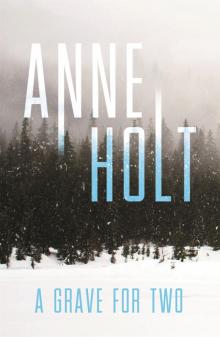 A Grave for Two
A Grave for Two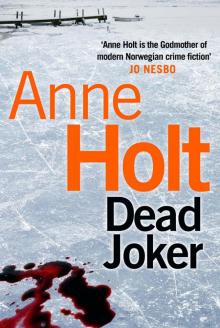 Dead Joker
Dead Joker Death of the Demon: A Hanne Wilhelmsen Novel
Death of the Demon: A Hanne Wilhelmsen Novel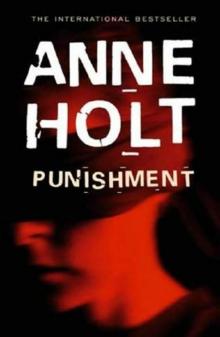 Punishment aka What Is Mine
Punishment aka What Is Mine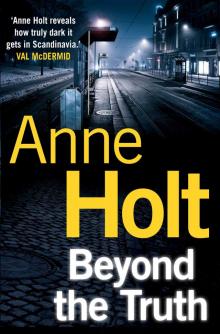 Beyond the Truth
Beyond the Truth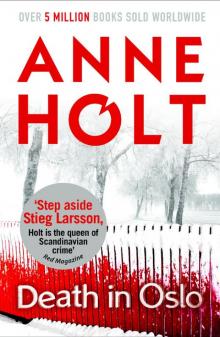 Death in Oslo
Death in Oslo The Blind Goddess
The Blind Goddess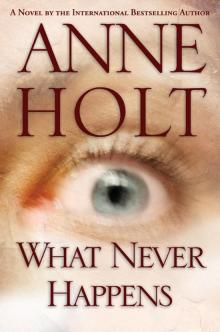 What Never Happens
What Never Happens 1222
1222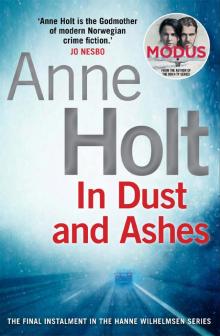 In Dust and Ashes
In Dust and Ashes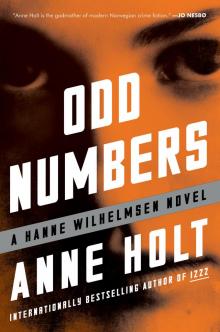 Odd Numbers
Odd Numbers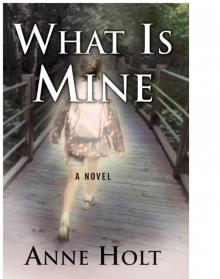 What is Mine
What is Mine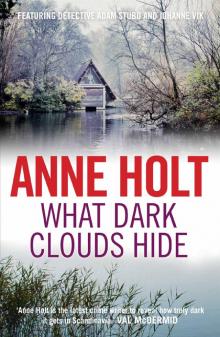 What Dark Clouds Hide
What Dark Clouds Hide Blessed Are Those Who Thirst
Blessed Are Those Who Thirst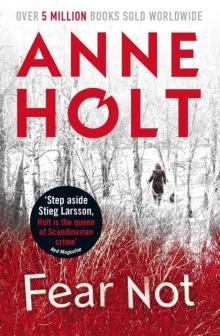 Fear Not
Fear Not No Echo
No Echo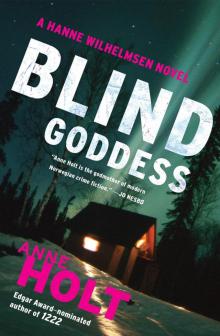 Hanne Wilhelmsen - 01 - The Blind Goddess
Hanne Wilhelmsen - 01 - The Blind Goddess